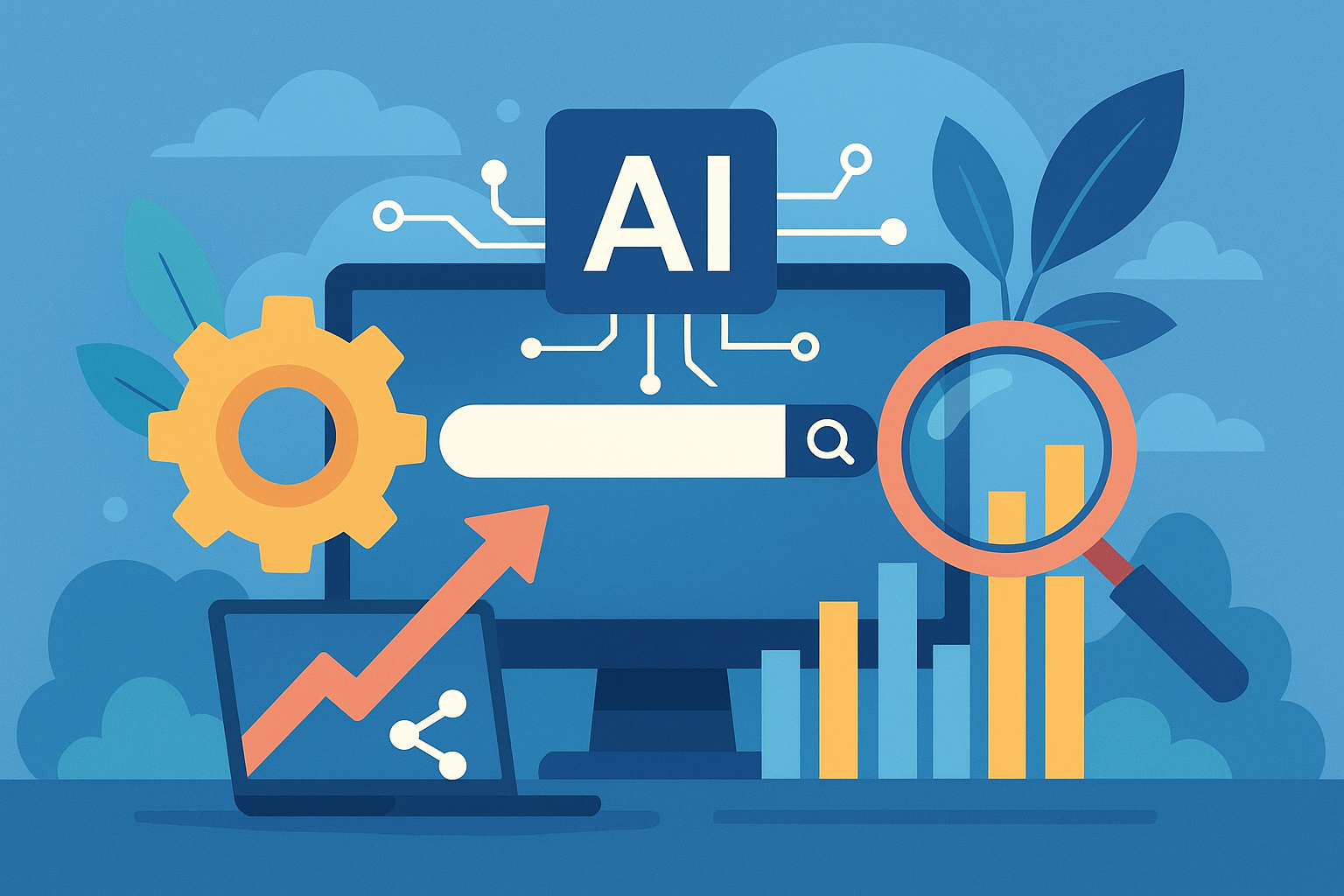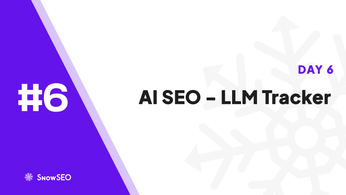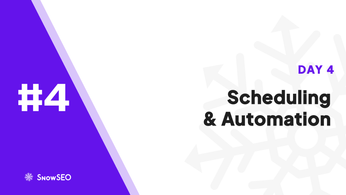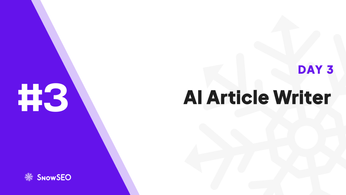
Expert Tips to Boost Your SEO for AI
Table of Contents
Discover how AI is redefining SEO. Search algorithms now rely on machine learning signals, real-time user intent modeling, and generative answers that appear above traditional links. That means the tactics that carried your site to page one last year could already be obsolete.
AI is changing the SEO landscape, making it crucial to adapt your strategies. Brands that fail to evolve risk losing visibility to competitors who embrace AI-driven optimization. From Google’s Search Generative Experience to voice assistants summarizing results, organic exposure shrinks for sites that don’t speak the same predictive language.
This guide will provide expert tips to leverage AI for boosting SEO. You’ll learn how to turn tools like ChatGPT, Jasper, and Surfer SEO into growth engines, train content to satisfy large-language-model crawlers, and capture clicks even inside zero-click SERPs.
Our team consults with leading AI and SEO experts to provide the latest insights, drawing on campaigns trusted by major brands and the 98% of digitally leading companies already harnessing AI.
Introduction to AI in SEO
Artificial intelligence has shifted SEO from guesswork to data-driven precision. Today’s smart algorithms analyze billions of signals in milliseconds, surfacing exactly what users need and rewarding sites that provide it. For marketers, that means AI SEO strategies are no longer optional; they are the engine behind higher rankings, richer snippets, and faster content optimization. Tools like ChatGPT, Jasper, and Surfer SEO turn raw data into actionable insights, helping brands anticipate user intent before the query is fully typed.
Key insight: 98% of digitally leading companies already leverage AI and search optimization together, leaving late adopters scrambling to catch up.
The Evolution of SEO with AI
- Keyword stuffing era (pre-2010) - engines favored density over relevance.
- Semantic search rise (2013-2018) - Google’s Hummingbird and RankBrain began interpreting intent.
- Real-time learning (2019-2023) - BERT and MUM understood context across languages and media.
- Predictive optimization (2024-present) - Generative models forecast trends, auto-optimize metadata, and personalize SERPs at scale.
| Milestone | AI Capability | Impact on SEO |
|---|---|---|
| RankBrain | Machine learning ranking | Better intent matching |
| MUM | Multimodal understanding | Cross-format content boosts |
| Generative AI | Predictive content creation | Faster, user-focused pages |
Master each phase to stay visible in an AI-first search landscape.
Also Read: AI SEO Trends That Drive Success in 2025
Essential AI SEO Strategies
Search engines are no longer just keyword matching machines - they are sophisticated prediction engines powered by machine learning models that evaluate user intent in milliseconds. To thrive in this environment, marketers need a fresh playbook focused on AI SEO strategies that combine data science, automation, and human creativity. The tactics below show exactly how to put AI and search optimization to work on your site right now.

Key insight: Brands using AI for on-page optimization report faster ranking improvements and a 25-35 % lift in organic traffic within six months.
1. Optimizing Content with AI Tools
AI editors such as ChatGPT, Jasper, and Surfer SEO have matured from novelty to necessity. Their real power lies in augmenting - not replacing - your editorial expertise.
- Draft smarter, not longer
- Feed the tool a tight brief with search intent, audience pain points, and brand voice guidelines.
- Generate multiple outline variations, then merge the strongest elements into a single structure.
- Elevate on-page signals
- Use NLP scoring features to identify missing entities (people, places, concepts) that Google’s algorithms expect for a topic.
Example: An article on “zero-trust security” should mention multi-factor authentication and micro-segmentation.
- Use NLP scoring features to identify missing entities (people, places, concepts) that Google’s algorithms expect for a topic.
- Create dynamic snippets
- AI can test thousands of meta title/meta description combinations in seconds, predicting click-through probability.
- Deploy the highest-scoring pair, monitor SERP performance, and iterate weekly.
- Tone and factuality checks
- Large language models occasionally invent statistics. Counter this by running outputs through fact-checking APIs and subject-matter expert (SME) reviews.
- Adjust reading level to meet search intent - conversational for B2C, authoritative for B2B.
Pro tip: Schedule quarterly “content audits” where AI flags underperforming pages and recommends semantic rewrites rather than wholesale rewrites, preserving link equity.
2. AI-driven Keyword Research
Traditional keyword tools scrape volumes and competition scores, but AI rewrites the process through predictive modeling.
| Research Stage | Manual Approach | AI-enhanced Approach | Benefit |
|---|---|---|---|
| Seed List Generation | Brainstorm and competitor URLs | Transformer models auto-expand topics using context similarity | Finds hidden long-tail gems |
| Opportunity Sizing | Rely on historic search volume | Combines volume with click-share forecasts and seasonality trends | More accurate traffic predictions |
| SERP Intent Mapping | Skim top 10 results | Classifies intent (information, transaction, navigation, local) at scale | Correct content format first time |
Bulletproof routine for AI keyword discovery
- Start with five core commercial terms.
- Let the model output semantically related questions (“People Also Ask” style).
- Cluster results by intent using vector embeddings.
- Assign each cluster a unique content asset: blog, comparison page, webinar landing page, etc.
By automating this pipeline, you reclaim hours of manual spreadsheet work and focus on crafting experiences that truly satisfy searchers.
3. Automation and AI in SEO
AI does more than write copy - it orchestrates entire SEO workflows:
- Internal linking automation
Graph-based algorithms crawl your site, uncover orphan pages, and suggest internal links with the highest topical relevance score. - Real-time technical monitoring
Machine learning models watch Core Web Vitals, crawl errors, and schema markup 24/7, alerting you to anomalies before rankings dip. - Predictive rank modeling
Instead of reacting to drops, AI forecasts ranking movements based on competitor velocity, backlink velocity, and algorithm update patterns.
Warning: Automation without oversight can create thin content or spammy link structures. Always pair AI outputs with human QA checkpoints.
Action Plan Checklist
- Integrate an AI content suite (ChatGPT API + Surfer SEO) into your CMS workflow within 30 days.
- Build an intent-driven keyword universe quarterly using vector clustering.
- Set up automated internal link recommendations and approve weekly batches.
- Review AI-generated technical alerts every morning; escalate critical issues to dev teams.
- Track improvements in indexed pages, average position, and conversions monthly.
Why These Strategies Win in 2025
- Humans alone cannot process Google’s 5000+ algorithm updates per year.
- AI reduces repetitive tasks, freeing strategists for creativity and relationship-building.
- Sites that marry machine precision with authentic brand voice earn higher E-E-A-T signals, the backbone of modern rankings.
By systemizing the approaches above, you transform AI from a buzzword into a measurable growth engine - one that keeps your search visibility climbing no matter how quickly algorithms evolve.
AI’s Impact on Traditional SEO Practices
Artificial intelligence has flipped the classic keyword-backlink equation on its head. Algorithms now interpret intent, sentiment, and topical depth in milliseconds, forcing marketers to rethink every optimization habit they once swore by.
Challenges and Opportunities
Key insight: Treat AI as a co-strategist, not a mysterious black box.
| Area | Traditional SEO Focus | AI-Driven Shift |
|---|---|---|
| Keyword Research | Exact-match terms | Semantic clusters |
| Content Creation | Manual drafting | Generative assistants |
| Ranking Signals | Backlinks volume | User satisfaction metrics |
- Major Challenges
- Unpredictable SERP volatility as AI testing layers change layouts hourly.
- Data overload from tools like Search Console, GA 4, and ChatGPT plugins.
- Talent gaps: writers and devs must now understand prompt engineering.
- Game-Changing Opportunities
- Hyper-personalized content at scale via Jasper or Surfer’s content briefs.
- Real-time on-page tweaks driven by predictive analytics.
- Automating tedious audits, freeing teams for creative strategy.
Action plan:
- Map topics, not keywords, to mirror how AI clusters context.
- Feed large language models with brand voice guides to avoid generic copy.
- Pair human editors with AI outputs to maintain originality and trust.
By balancing these moves, brands protect legacy rankings while unlocking AI’s speed and pattern-recognition superpowers.
Also Read: 2025’s Best AI SEO Tools That Deliver Results
Future Trends in AI and SEO
Search algorithms now evolve in weeks, not years, and that pace will only accelerate through 2025. Marketers who ignore AI future trends risk fading into the SERP abyss. Below is a snapshot of where the search landscape is heading and how you can stay visible.

Key Shifts on the Horizon
- Intent-centric ranking – Engines will rely on large language models to decode nuanced user intent, rewarding pages that answer the “why” behind a query.
- Generative SERP features – Expect dynamic, AI-written summaries that pull from multiple sources, shrinking traditional organic real estate.
- Real-time content scoring – Machine learning systems will evaluate freshness, engagement signals, and entity coverage on the fly.
- Hyper-personalized experiences – Search results will adjust per user persona, device, and moment, demanding adaptable content architecture.
| Emerging Trend | SEO 2025 Impact | Immediate Action |
|---|---|---|
| Intent-centric ranking | Keywords alone lose weight | Map topics to searcher jobs-to-be-done |
| Generative SERP features | Fewer blue-link clicks | Optimize for featured summary extraction |
| Real-time scoring | Rankings fluctuate hourly | Automate performance monitoring |
| Hyper-personalization | One size fits none | Build modular content blocks |
Pro Tip: Treat every page like a knowledge graph node. Explicit relationships between entities future-proof your content against semantic updates.
Preparing for the Future of AI
- Audit content gaps quarterly using AI tools such as Surfer SEO to match evolving intents.
- Invest in structured data today; schema becomes the default language for machines tomorrow.
- Create an AI governance plan outlining acceptable automation, data privacy safeguards, and human review checkpoints.
- Upskill teams on prompt engineering and conversational UX design so they can collaborate naturally with systems like ChatGPT and Jasper.
Marketers embracing these SEO 2025 realities will ride the algorithmic waves-rather than get swept beneath them.
Ready to put these expert tips into action and dominate both search engines and AI platforms? Implement these AI strategies to stay ahead in SEO by letting SnowSEO handle the heavy lifting. Our all-in-one platform pinpoints lucrative keywords, generates human-quality content, and automatically publishes to your CMS while you focus on scaling your business. Instead of juggling five different tools, SnowSEO unifies research, creation, and tracking in a single, intuitive dashboard-saving you hours every week and slashing subscription costs.
Here’s your next move:
- Visit snowseo.com and start a free audit to see exactly where your content can outperform competitors on Google, ChatGPT, and Bing.
- Activate the 14-day trial to experience automated keyword clustering, on-page optimization, and AI mention monitoring in real time.
- Schedule a strategy call with our 24x7 AI expert team to uncover hidden content gaps and receive a customized roadmap for rapid organic growth.
Take the first step now-your future rankings depend on how quickly you act.
Frequently Asked Questions
Q1: How do AI tools like ChatGPT fit into my existing SEO workflow?
AI writers shine when they shoulder the heavy lifting of ideation and first-draft creation. Keep strategic tasks-audience research, brand voice policing, final edits-in human hands. Feed ChatGPT structured briefs, then run the output through Surfer SEO to fill content gaps before publishing.
Q2: Will optimizing for AI search hurt my rankings on traditional search engines?
No. The optimizations that help AI assistants understand your content-clear structure, factual trust signals, precise schema-also reinforce Google’s E-E-A-T guidelines. As long as you avoid keyword stuffing and maintain user intent as your north star, AI optimization and traditional SEO move in the same direction.
Q3: What is the quickest win I can implement today to make my site more AI-friendly?
Add intent-rich FAQ schema to your top traffic pages today. It takes minutes in most CMSs, yet instantly gives language models a concise knowledge graph of your brand. The result: richer AI answers, higher click-through from answer boxes, and improved voice-search visibility.
Conclusion
AI has shifted SEO from a purely keyword-centric discipline to a data-rich, prediction-driven practice that rewards human-focused content and technical finesse alike. Brands that thrive in 2025 are the ones that pair human creativity with machine efficiency, using tools like ChatGPT for ideation, Surfer SEO for on-page optimization, and Jasper for rapid content iterations. When algorithms change overnight, the teams already experimenting with AI-driven insights react in hours instead of months, protecting hard-won rankings and audience trust.
Key Takeaways
- Embrace AI tools for enhanced SEO: Automate repetitive audits, surface hidden opportunities, and allocate more time to strategic storytelling.
- Stay updated with AI developments: Search engines now release AI model updates almost as often as smartphone patches-continuous learning is non-negotiable.
- Integrate AI-driven strategies gradually: Pilot small features such as automated meta tag generation before overhauling your entire stack.
Call to Action
Implement these AI strategies today to stay ahead in SEO and safeguard future visibility.
Next Steps
- Audit your current SEO tech stack.
- Identify one AI tool that solves your biggest bottleneck.
- Measure performance gains, iterate, and scale the approach.





